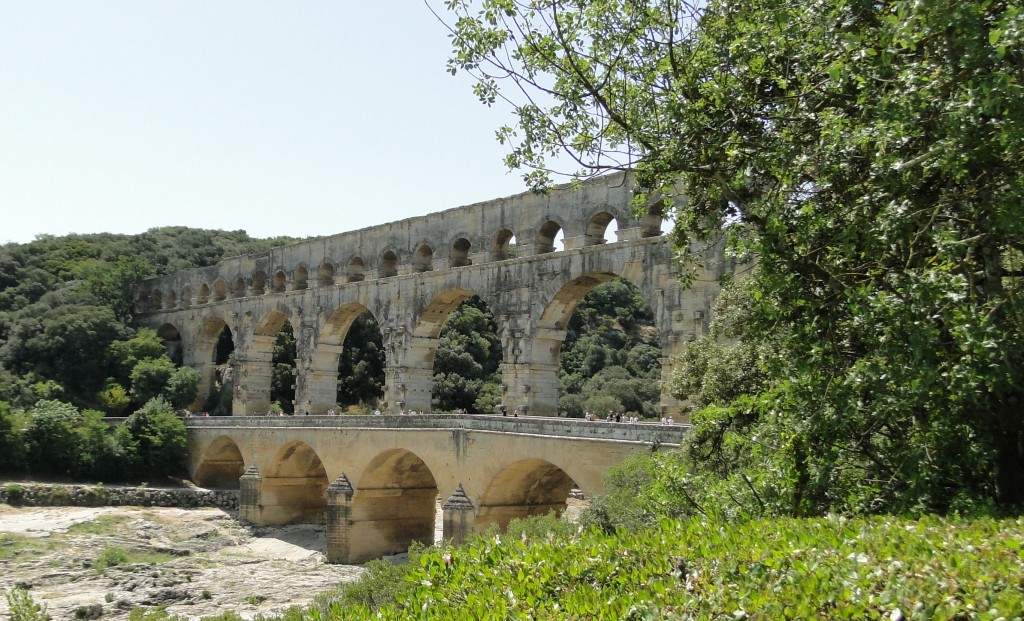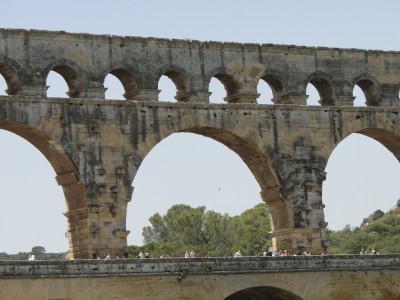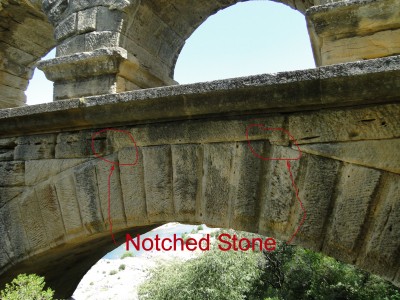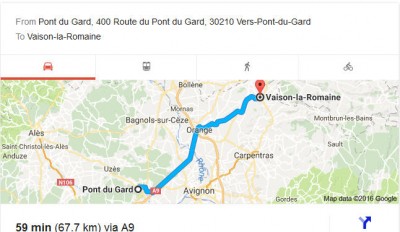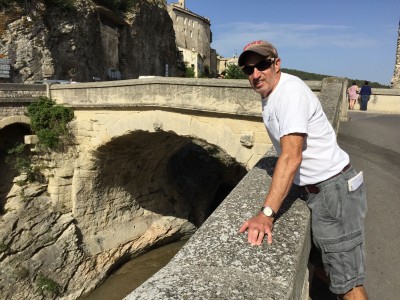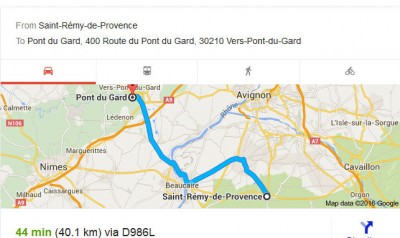 Today was day-three of our four-day driving trip through Provence.
Today was day-three of our four-day driving trip through Provence.
After a delightful stroll through the Wednesday morning market of Saint-Rémy, we again hit the road. Destination: Pont du Gard.
The Pont du Gard is the world famous Roman aqueduct, one of the most visited spots in France and a UNESCO World Heritage site. As a mechanical engineer and a lover of history, Henry Warner is hard-pressed to come up with enough superlatives to convey his impressions. A few of them that come to mind are magnificent, awesome, unbelievable, incredible, masterful, not-to-be-missed, and mind-boggling.
A few facts about the Pont du Gard: The aqueduct was built in the first century AD and runs 50 KM (31 miles). It does not run in a straight line, but curves around hills over uneven terrain and even tunnels through some hills.
The water source is only 56 feet higher than the destination point, which translates into an astounding average elevation drop of only one inch per 350 feet of travel. At the point it crosses the river Gardon, the three-tiered arched structure is 160 feet tall. One can only marvel at the skill of the Roman builders, who, in the days before GPS, surveyor scopes and computers, could achieve this level of precision over such a long distance. Absolutely incredible!
Each stone block in the bridge weighs between two and six tons. All blocks are precisely cut and held in place without mortar. Note the notched cap stone in the adjacent photograph used to counter lateral forces.
It is estimated that up to 1,000 workers spent 15 years building the aqueduct, with the Pont du Gard itself taking five years.
After a couple of hours marveling at the Roman masterpiece of Pont-du-Gard, Rich, Dawn, Jill and Henry Warner were off to our next Roman destination: Vaison-la-Romaine.
Vaison-la-Romaine is a lesser-visited tourist destination in Provence that we all really enjoyed. It has a very authentic, old look and feel, yet without the horde of summertime tourists. While the “Romaine” in the town’s name hints at a Roman founding, the town was actually a Celtic capital as early as the 4th century BC – long before the Romans arrived.
Vaison-la-Romaine has a long and complicated history. It is hard to keep track of when and who invaded and/or ruled the town. Probably because of this, it is a fascinating place to visit for anyone interested in both Roman and medieval artifacts, as the town has a huge supply of both.
Vaison-la-Romaine consists of an upper town and a lower town. The lower town is where the Romans settled and built what became one of the richest cities in Roman Provence. They also built a solid bridge (which is still in use today) over the Ouvèze river, which separates the upper from the lower towns.
The upper town, by contrast, is predominantly medieval. During the middle ages the townsfolk migrated to higher ground and built a château for defense. In a stroke of good fortune, it turned out that Dawn had booked us into a B&B that was the 16th century home of the local bishop. How cool is that!
After getting a tour of the residence and checked-into L’Evêché (the bishopric in French) by our very gracious hosts, Aude & Jean-Loup Verdier, we set off to see the sights of the lower town. The excavated Roman town and arena ruins were closing shortly, so we decided we didn’t have a enough time to justify the admission price. As a consolation prize, however, we discovered an enjoyable wine-tasting establishment called Arbre de Vin. We each sampled eight local wines poured by a young man who is going to make his first trip to the US this November. I spoke to him in French and he spoke to us in English, so we each got in some practice. All the wines we sampled were good. So good that we bought eight bottles.
We had a pleasant meal outside at the Belle Etoile and got back to our B&B sometime after 10:00 PM. None of the rooms have A/C, but all were equipped with fans and we had no problem sleeping, even though the day had been quite warm.
After a typical French breakfast served by our hosts, we did some more sight-seeing. This time we concentrated on the upper, medieval part of town, including a hike up to the château ruins. It just doesn’t get any better than this for a history buff like Henry Warner! Then we packed up and headed to our final road trip destination: Roussillon.


